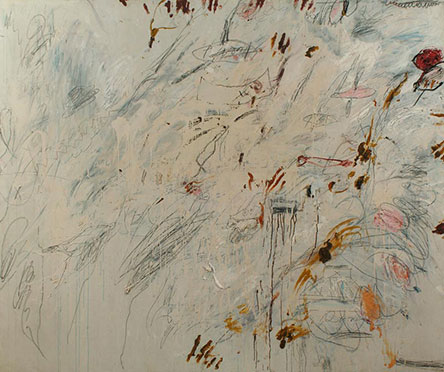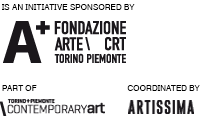
Cy Twombly, Untitled (Roma [Il muro]), (1961),
oil, enamel, graffiti and charcoal on canvas, 200x241 cm
GAM Galleria Civica d’Arte Modernae Contemporanea, Turin.
Photo: Studio fotografico Gonella
GIORGIO VASTA
on Senza titolo (Roma [Il Muro]) by Cy Twombly
GAM - Galleria Civica d’Arte Moderna e Contemporanea
It’s 1961. Cy Twombly has moved to Rome and set up a studio near the Campo de’ Fiori. From here he can probably watch the comings and goings of the market, can definitely hear the fragmented voices of hawkers and buyers. That is to say, he hears language in that intermediate life it has when individual phonemes have not yet been grouped into words, when words have not yet arranged themselves into phrases, when phrases have not yet formed a discourse: that is to say, when every syllable is both sound and bedazzlement.
What Twombly listens to from his studio is language half-asleep; as if a pane of frosted glass, blocking a clearer perception, protected and revealed its original substance.
Language that has only just begun to hatch into meaning, with shards of eggshell scattered all around.
Language the way a baby might hear it.
Language as a child.
For four years, just down the street from Campo de’ Fiori, Twombly listens to this newborn language, and paints it.
In Untitled (Roma [The Wall]), the canvas is an ear, an adhesive surface that captures and holds the muddle of voices. A space in which a change of state occurs that renders the acoustic visible: we perceive the substance of the voices.
In the upper right is a red clot that looks like wax (the seal on a canvas envelope containing not words so much as the materials used to construct them, prelinguistics in action), and further down, mustard-yellow smudges, streaks and swirls and then pools of pink, brownish or reddish curlicues, thin grey scorings of the surface – other marks that look like confirmations, graphic babbling, archipelagos of corpuscles, an erratic swarm of embryonic particles.
Twombly stops, listens: the air all around him is drenched with language. He goes back to the canvas, lets the paint drip down, picks up the charcoal and pulls out a tangle of lines. Takes a step back, looks: every mark on the canvas is snarled or unsnarled; it’s taut, it’s twisted. Because the materials that compose language are made of reverberation, trembling, invisible turmoil, a fever that rattles form; they are filamentary materials with quick-whipping flagellate tails.
Another step forward, a movement of his hand, and when its trajectory ends and his arm comes back to his body, on the canvas – in the lower right, in rapid cursive – the word Roma has materialized, so faint it’s like a whisper.
Twombly moves aside, observes the voice brought to light.
Then he rubs his eyes and in his eyes the phosphenes fire.
